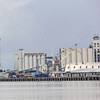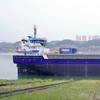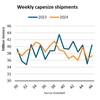Naval Sea Systems Command (NAVSEA) commander Vice Admiral Phillip M. Balisle USN was the honorary speaker at this year's patent award ceremony at NAVSEA’s Carderock Division in Bethesda. The event recognizes outstanding creativity in science and engineering accomplished by Navy civilian employees of the division.
The vice admiral recognized the 1,640 patents awarded to the division since 1940 compared to other government agencies. "I am stunned at the number of patent recipients. This is not just an award but more a recognition of a culture, of a profession, on the leading edge of what we do for the nation.” He said he was overwhelmed by the relevance of the latest patents.
He underscored the need to rapidly transition these technologies to the Navy. "As the Navy reshapes itself, it is trying to be innovative in a changing world. We must move fast, take risks and rely on the few with technical skills to do things not thought of before."
In recognition as keynote speaker, Vice Admiral Balisle was inducted as an honorary member of the Carderock Division Inventors Club. He was cited for his leadership in fostering an environment for innovation and transformation supporting the fleet and warfighter of today and tomorrow.
Patents and inventions constitute an essential measure leaders use ensuring Carderock stays on the forward edge of innovation and technology advancement.
From June 1, 2003 – July 31, 2004, 71 inventors earned 40 patents associated with Carderock programs. These innovators are individually honored for significant contributions to the U.S. Navy (and to the United States). At the same time, 30 of the 71 employees are first-time inventors specially recognized by induction into the Carderock Inventors Club, a command honor society celebrating issuance of the first U.S. patent bearing a Navy civilian inventor's name. In addition, 68 employees are being recognized for filing 49 patent applications covering Navy inventions during the same period.
Noteworthy patented technologies include a mine littoral threat zone visualization program, fiber-optic composite material damage sensing, underwater target testing, underwater detection and deterrent system, integrated circuit protection software, automatic reconfiguration of damaged electromechanical systems, processing of ship wastewater, ship motion stabilization, enhanced vessel hydrodynamics, ship signature reduction, life saving and safety systems, as well as ship machinery enhancement.
Featured videos

Inside the Electrified Truckable Tug

Tracking Foreign Vessels Working in the U.S. Jones Act Market

Inmarsat Enhances Service to Drive Digitalization
Subscribe for
Maritime Reporter E-News
Maritime Reporter E-News is the maritime industry's largest circulation and most authoritative ENews Service, delivered to your Email five times per week









